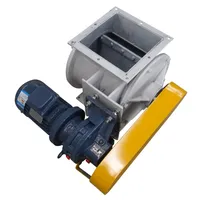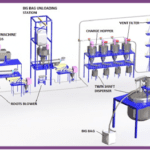ROTARY AIRLOCK VALVE
A rotary valve is a mechanical device used to control the flow of bulk materials or fluids in a system. It consists of a rotating rotor with vanes or blades housed within a casing. The rotor is mounted on a shaft and is driven by a motor or other power source. As the rotor rotates, the vanes or blades create chambers that alternately allow or block the flow of material or fluid through the valve.

Rotary valves are commonly used in various industries, including food processing, pharmaceuticals, chemical manufacturing, and power generation. They offer several benefits and applications:
Material Flow Control: Rotary valves provide precise control over the flow of bulk materials, such as powders, granules, pellets, or other dry solids. They can be used to regulate the discharge of material from hoppers, bins, or silos, or to feed material into processing equipment or conveyors.
Airlock Function: Rotary valves are often used as airlocks to maintain a pressure differential between different process areas. They prevent air or gas leakage while allowing a continuous flow of material, making them suitable for pneumatic conveying systems or applications requiring controlled atmospheres.
Metering and Batch Feeding: Rotary valves can be utilized for accurate metering or batch feeding of materials. The rotation speed and design of the valve can be adjusted to control the volume of material being discharged, ensuring precise dosing or batching.
Abrasion and Wear Resistance: Rotary valves are available in various materials, including stainless steel, hardened steel, or other wear-resistant alloys. This makes them suitable for handling abrasive materials or substances with high temperatures or corrosive properties.
Explosion Prevention: In industries where combustible dust or gases are present, rotary valves can be designed with special features to minimize the risk of explosions. These features include explosion-proof construction, venting options, and spark-resistant components.
Easy Maintenance and Cleaning: Rotary valves are typically designed for easy maintenance and cleaning. The rotor and casing can be easily accessed for inspection, cleaning, or replacement of parts without the need for disassembly of the entire system.
It’s important to select the appropriate rotary valve based on the specific application requirements, such as the type of material, flow rate, pressure, temperature, and the desired level of control. Factors like rotor design, sealing mechanisms, and construction materials should be considered to ensure compatibility with the material being handled and the operating conditions.
Consulting with experienced engineers or rotary valve manufacturers is recommended to determine the most suitable rotary valve design and specifications for your application.
KEY BENIFITS
- Prevents cross-contamination
- Maintains pressure differential
- Easy to clean
- Durable

